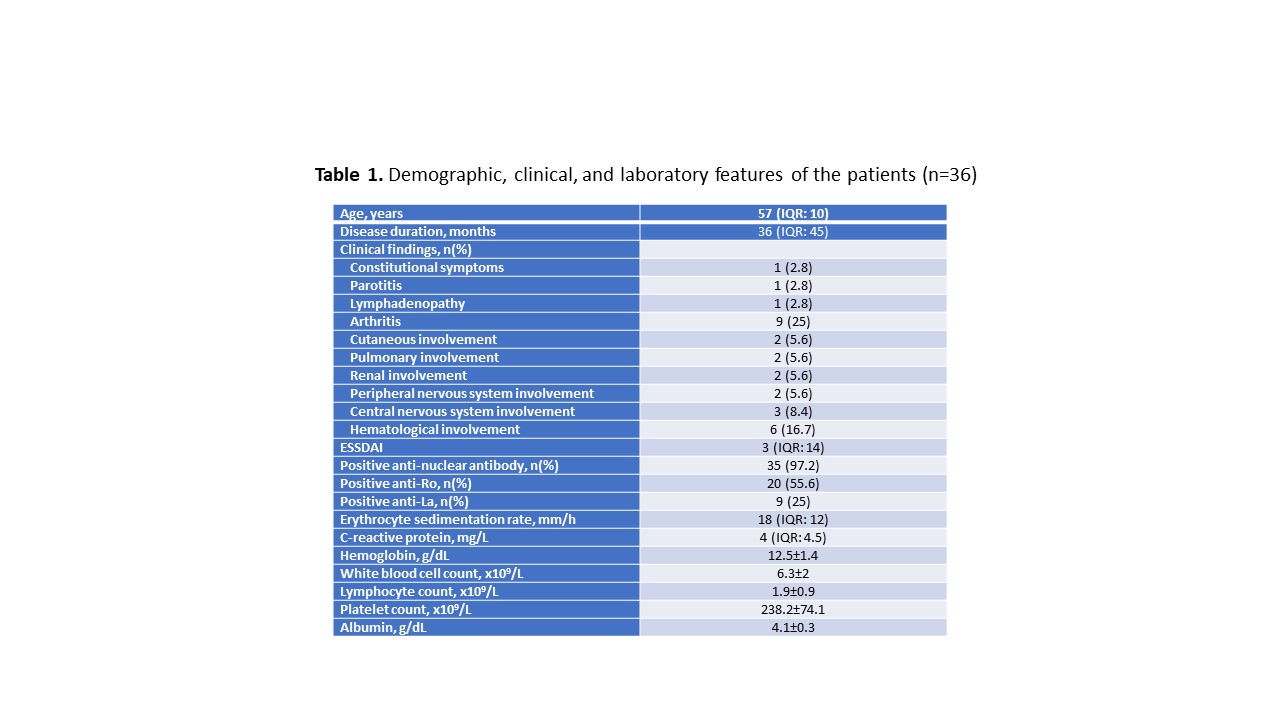Session Information
Date: Saturday, November 6, 2021
Title: Sjögren's Syndrome – Basic & Clinical Science Poster (0296–0322)
Session Type: Poster Session A
Session Time: 8:30AM-10:30AM
Background/Purpose: Since primary Sjögren’s Syndrome (pSS) is a very heterogeneous disease with systemic manifestations, factors influencing the outcome of patients with pSS need to be investigated. Considering previous evidence suggests that markers of serum albumin level and lymphocyte count might be able to predict inflamatory burden, we hypothesised that PNI, calculated from the serum albumin level and total lymphocyte count, could represent convenient and cost-effective biomarker for predicting disease activity in pSS. Therefore, we aimed to investigate the association of PNI with Sjögren disease activity measured by validated EULAR Sjögren’s Syndrome Disease Activity Index (ESSDAI).
Methods: In this this cross-sectional study, we included a total of 36 women adult patients with pSS met the 2016 ACR-EULAR Classification Criteria for primary Sjögren’s Syndrome which was evaluated in rheumatology clinic from January 2020 to January 2021. We collected laboratory data including erythrocyte sedimentation rate (ESR), C-reactive protein (CRP) level, lymphocyte, and serum albumin levels at diagnosis and last visit. PNI at diagnosis was calculated as (10 × serum albumin [g/dL] + 0.005 × lymphocyte count [/mm3]). Disease activity was assessed with ESSDAI scores, visual analogue scales (VASs) (global disease, pain, and fatigue) was determinated and compared with PNI.
Results: Median age and disease duration were 57 (IQR: 10) years and 36 (IQR: 45) months, respectively. Demographic, clinical and laboratory features of the patients were provided in Table 1. PNI at the time of diagnosis was 49.9±5.5 and found to be slightly lower in patients with positive anti-Ro antibodies (48.4±5.8 and 52.3±3.7, p=0.023). Baseline PNI also correlated with white blood cell and platelet counts and serum complement levels but not with ESR and CRP (Table 2). Current PNI was 50.1±4.9 and not statistically different from the baseline PNI (p=0.773). It had a moderate negative correlation with ESSDAI (rho=-0.518, p=0.002) but not with the patient global (r=-0.118, p=0.512), physician global (r=-0.134, p=0.456), pain (r=-0.114, p=0.526), and fatigue (r=-0.091, p=0.615) VAS scores. There was a quadratic relationship between the PNI and ESSDAI (Figure 1a). Patients with an ESSDAI of 3 or more had significantly lower PNI compared to those with an ESSDAI of 0 to 2 (45.4±3.2 and 53±4.3, p< 0.001) (Figure 1b).
Conclusion: Our study demonstrates that pSS patients with higher ESSDAI scores had lower values of baseline PNI calculated at the disease diagnosis. In the present study, to the best of our knowledge, we have first evaluated the clinical significance of PNI in patients with pSS. We hypothesize that a lower PNI at diagnosis could indicate a higher inflammatory burden and PNI might be a prognostic tool in pSS however future studies with larger numbers of patients may provide additional information regarding the role of PNI in pSS patients.
To cite this abstract in AMA style:
Kalkan K, Ilgen U, Ademoğlu Z, Emmungil H. Correlation Between Prognostic Nutritional Index and Primary Sjögren’s Syndrome Disease Activity [abstract]. Arthritis Rheumatol. 2021; 73 (suppl 9). https://acrabstracts.org/abstract/correlation-between-prognostic-nutritional-index-and-primary-sjogrens-syndrome-disease-activity/. Accessed .« Back to ACR Convergence 2021
ACR Meeting Abstracts - https://acrabstracts.org/abstract/correlation-between-prognostic-nutritional-index-and-primary-sjogrens-syndrome-disease-activity/



